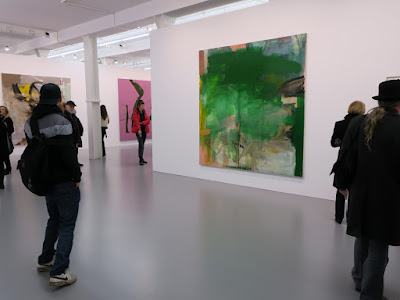 |
| Albert Oehlen |
 |
| Julian Schnabel |
 |
| Julian Schnabel (detail) |
 |
| Julian Schnabel (detail) |
 |
| Albert Oehlen |
 |
| Albert Oehlen (detail) |
 |
| Julian Schnabel, Albert Oehlen |
 |
| Albert Oehlen |
 |
| Albert Oehlen (detail) |
 |
| Albert Oehlen |
 |
| Albert Oehlen |
 |
| Albert Oehlen (detail) |
 |
| Julian Schnabel |
 |
| Julian Schnabel (detail) |
 |
| Julian Schnabel |
 |
| Julian Schnabel |
 |
| Albert Oehlen |
 |
| Julian Schnabel |
 |
| Albert Oehlen (detail) |
 |
| Albert Oehlen (detail) |
Berlin: Goethestraße 2/3,
14 March – 14 April 2018
Press Release: Galerie Max Hetzler is pleased to announce an exhibition with new paintings by Albert Oehlen and Julian Schnabel at Goethestraße 2/3.
Both
known as major protagonists of a constant exploration of the process of
painting, Albert Oehlen and Julian Schnabel deeply influenced and
defined the art field since the 1980s, provoking a departure from
painting as conventionally understood. For the first time, Galerie Max
Hetzler presents a duo exhibition of these artist companions and
friends, focussing on their recent bodies of works.
With a
chromatic spectrum consisting mainly of subtle variations of grey,
including highlights of green, yellow and pink, the canvas’ surface of
Albert Oehlen’s latest paintings witnesses a complex and intriguing
process of overpainting. The elaborated interplay of broadly applied
brushstrokes and overlapping layers of paint build a dynamic impression
of colour and movement. Shapes and compositional patterns are generated
and often immediately dissolved during the work process, creating an
intense atmosphere of a painterly landscape that emerges out of the
captivating pictorial depth.
Alongside these paintings, several
works on paper allow an inside into this particular part of Oehlen's
multifaceted oeuvre. A recurring motif in the artist's work, the tree
appears as the central topic of this group of works. It serves as a
simple element which gives the artist the liberties to examine form and
line making. Black shapes, ink and pencil lines, mere silhouettes of a
leafless tree, structure the paper. Even though the affinity and
interaction is clearly visible, Oehlen's works on paper distinguish
themselves from his paintings, marking an independent category and a
kind of distillation of his painterly work.
The exhibited series
of new works by Julian Schnabel consists of six paintings made from
material that was used to cover an outdoor market in Mexico. A vibrant
pink dominates the background, while fir green and dark purple
brushstrokes delineate different compositional elements on the surface.
The works are characterised by a formal unity as each of them is
populated by variations of lines and organic shapes. The distinctively
individual, yet interweaving forms evoke landscapes, flowers and
figures. While bearing a strong representative potential, each painting
still triggers the viewer’s imagination. As a whole, the series
constitutes a gestural and poetic field that is reinforced by the sheer
physicality of the found fabric.
Schnabel considers found
materials, their physical characteristics as well as history essential
components of his painterly compositions. In the present series, the
linen pieces are marked by stains, stitches, holes and ripples that
testify to their previous use as covers for fruit and vegetable stands
in the market of Zihuatanejo.
Completing this duo exhibition,
two works depict portraits of Albert Oehlen and Julian Schnabel, painted
by the respective other. Schnabel realised his portrait of Oehlen in
1997 as part of his series of resin portraits, while Oehlen's portrait
of Schnabel was created just recently in 2018. Each painting clearly
bears the painterly gestures of its particular period in the artist's
career while emphasising the special relationship the two painters
share.
Albert Oehlen
(*1954, Krefeld) lives and works in Switzerland. Since 1981, he has
been exhibiting regularly at Galerie Max Hetzler. Oehlen‘s work has been
shown in numerous solo exhibitions in international institutions, such
as Museo Nacional de Bellas Artes, Havana (2017); Cleveland Museum of
Art and Guggenheim, Bilbao (both 2016); New Museum, New York and
Kunsthalle Zürich, Zurich (both 2015); Museum Wiesbaden (2014); mumok,
Vienna (2013); Kunstmuseum Bonn (2012); Carré d‘Art de Nîmes (2011);
Musée d‘Art Moderne de la Ville de Paris (2009); Whitechapel Gallery,
London (2006); MOCA, Miami; Kunsthalle Nürnberg, Nuremberg (both 2005);
Musée Cantonal Des Beaux Arts, Lausanne; Domus Artium 2002, Salamanca
and Secession, Vienna (all 2004) among others. A major survey is
scheduled in April 2018 at Palazzo Grassi in Venice.
Julian Schnabel
(*1951, Brooklyn) lives and works in New York, Montauk and San
Sebastian. His work has been exhibited in numerous solo and group shows
at international institutions, such as the Royal Academy, London;
Whitney Museum of American Art, New York (both 2017); Aspen Art Museum
(2016); Museu de Arte de São Paulo Assis Chateaubriand (2014); The
Metropolitan Museum of Art, New York; Martin-Gropius-Bau, Berlin;
Kunsthalle Bern (all 2012); Museum für Moderne Kunst, Frankfurt/Main
(2011); MOCA Grand Avenue, Los Angeles (2009); Contemporary Art Museum
Kiasma, Helsinki; Tate Modern, London (both 2008); Beijing World Art
Museum, Beijing (2007); Museo Nacional Centro de Arte Reina Sofía,
Madrid (2004), among others. Schnabel’s paintings are part of many
prominent collections, including Museum of Modern Art, New York; Musée
National d'art Moderne, Centre Georges Pompidou, Paris; Whitney Museum
of American Art, New York; Hamburger Bahnhof, Berlin; Stedelijk Museum,
Amsterdam; Solomon R. Guggenheim Museum, New York; and the Tate Gallery,
London.

























No comments:
Post a Comment